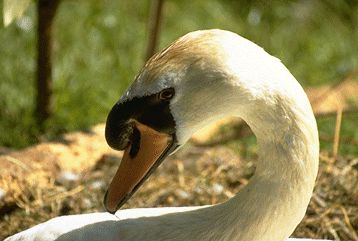Mute Swan
 The mute swan is one of the largest birds able to fly, with a length of one and a half meters, a wing span of 2 to 2 ½ yards and a weight of 4 to 6 pounds. The young are dull grey brown at birth with a dark gray bill. By adulthood, they have become brilliant white and the bill is orange with a black knob. Mute swans do not trumpet, but they do hiss and make barking noises to defend their territory.
The mute swan is one of the largest birds able to fly, with a length of one and a half meters, a wing span of 2 to 2 ½ yards and a weight of 4 to 6 pounds. The young are dull grey brown at birth with a dark gray bill. By adulthood, they have become brilliant white and the bill is orange with a black knob. Mute swans do not trumpet, but they do hiss and make barking noises to defend their territory.
Mute swans are found in most of Europe, Russia and China. They have been introduced to many parts of the world from North America to New Zealand. They prefer land with slow-flowing water and rich vegetation. They feed on aquatic plants, insects and small fish. The knob on the bill is a super sensitive feeler assisting them in finding food underwater.
The mute swans will do a courting display then settle down with one mate for life. If the mate is killed they will seek a new mate. Breeding couples will vigorously defend their territory. In addition to the hissing and barking, a swan is strong enough to break a humans arm and will attack other swans, dogs or people if threatened. The average life span of a mute swan in the wild is about 18 years, though in captivity they may live to 40 years.
When not breeding, they will congregate in groups and as winter approaches, swans living in northern areas migrate together. Many birds die during migrations south, because they are too young and unprepared to make the long journeys.
Symbolism: For many cultures the white swan is a symbol of light, both as a feminine symbol of the moon and a masculine symbol of the sun. In Greek mythology, the swan has been linked to Apollo, to Zeus who took the shape of a swan to seduce Leda, to Aphrodite and Artemis who were sometimes shown accompanied by swans.
Many cultures have stories incorporating the swan as a symbol of transformation and many of the people transformed in the stories are women.
In the symbolism of Alchemy, the swan was neither male nor female, but the "marriage of opposites", fire and water. It was associated with Mercury as it was white and winged.
Dreaming of a swan may signify self-transformation, intuition, sensitivity, the soul.
Folklore is filled with tales of people and sometimes the gods changing into swans.
-Zeus changed himself into a swan as a means of seduction. (Greek)
-The children of Lir were changed into swans for 900 years until the spell holding them was broken. (Celtic)
-The Valkyries, warrior goddesses who chose the warriors to enter Valhalla after death, had the power to transform into swans. If a man stole their plumage, they were forced to obey him. (Germanic)
-Swans took off their plumage in fairy tales, revealing themselves as maidens (Celtic, Siberian and European)
-In Tchaikovsky's Swan Lake, Princess Odette is changed into a swan.
-The Eleven Swans by Hans Christian Anderson, the story of Even princes, transformed into swans and their sister who must remaining mute, sew eleven shirts in seven years, to change them back again.
-In the Ugly Duckling, also by Hans Christian Anderson, it is the "duckling" itself that transforms into a noble swan, discovering it's true self.
-In the story of Lohengrin, "a popular medieval Arthurian legend ... the theme of the earliest written version of the legend, the epic Parzival (circa 1210), by the German poet Wolfram von Eschenbach.": [Lohengrin] was the son of Parzival ... the knight of the Holy Grail. At King Arthur's command, Lohengrin was taken by a swan-drawn boat to Antwerp, where he fought for a noble lady, Elsa of Brabant. In the city of Kleve in west central Germany near the Rhine there is a castle called the "Schwanenburg" (Swans' Castle). This is in some manner associated with the Lohengrin legend and the "Knights of the Swan".
Encarta Encyclopedia.
http://www.dierinbeeld.nl/animal_files/birds/mute_swan/